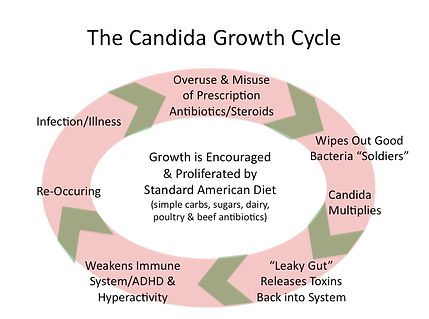Candida

While antibiotics effectively kill both pathogenic and beneficial bacterial strains with the exception of antibiotic-resistant species of streptococcus and other strains, they do not affect the many forms of yeast such as Candida albicans naturally found in the body in a nondominant role.

As beneficial bacteria lining the gut wall are eliminated, yeasts like Candida albicans have the opportunity to overgrow and become dominant by attaching to the gut wall. Once attached to the gut wall, yeast has the ability to create lesions in the cell membranes. This can lead to the syndrome referred to as “leaky gut”, which increases the likelihood of foreign proteins entering the bloodstream resulting in inflammation, food intolerances, a myriad of digestive problems, autoimmune disease, and other associated imbalances.

Symptoms of Candida can be as subtle as that rash you can't explain or that incredible craving for sweets. Here are some of the wild and wonderful things candida can do to you when its taking over.
Candida Saliva Test
When you awake in the morning, before you put anything into your mouth, work up some saliva and spit it into a clear glass of water. Within 1-3 minutes, look in the glass. If there are strings coming down from your saliva, or if the water turned cloudy, or if your saliva sank to the bottom, YOU MAY HAVE A CANDIDA CONCERN! Healthy saliva will simply float on the top! (You may want to put out a glass of water in the bathroom or on the nightstand the night before you wish to do the home Candida Saliva test, just to remind yourself not to brush your teeth prior to spitting into the glass.) more

8 Foods To AVOID On The Candida Diet
1. Sugar in all its forms — feeds candida.
2. Fruit. It's called "nature's candy" for a reason.
3. Grains. Grains are another form of sugar, and should also be avoided. That's especially so for those containing gluten, which can be very damaging to the gut.
4. Alcohol
Alcohol is tough on your intestinal lining, and is even linked to leaky gut syndrome.
5. Dairy
The one exception I would make is grass-fed, full-fat, cultured dairy foods like kefir and yogurt.
6. Starchy plant foods
Starchy vegetables like potatoes, yams, and beets can feed the yeast overgrowth.
7. FODMAPS
8. Conventional coffee More

Candida Die-off
or
Herxhiemer's Reaction
When yeast cells are rapidly killed, a die-off (or Herxheimer reaction) occurs and metabolic by-products are released into the body. The Candida yeast cells actually release 79 different toxins when they die, including ethanol and acetaldehyde.
Acetaldehyde in particular has a whole host of detrimental effects on your health and wellbeing. It can impair your brain function and even kill brain cells. Your endocrine, immune and respiratory systems can all be affected, and it also damages the membranes of your red blood cells, reducing their ability to carry oxygen round the body. Again this directly affects your brain, so you can see how acetaldehyde is linked to Candida symptoms like brain fog and fatigue. These by-products also cause allergic reactions and inflammation that lead to an array of undesirable symptoms.

Candida Die-Off symptoms will vary from person to person, as each will have different degrees of infestation. If you are having severe Die-Off symptoms, slow down your treatment and reduce your dosage of probiotics and antifungals. The liver is your main pathway for eliminating toxins, and the Die-Off symptoms mean that it is being overwhelmed. more


